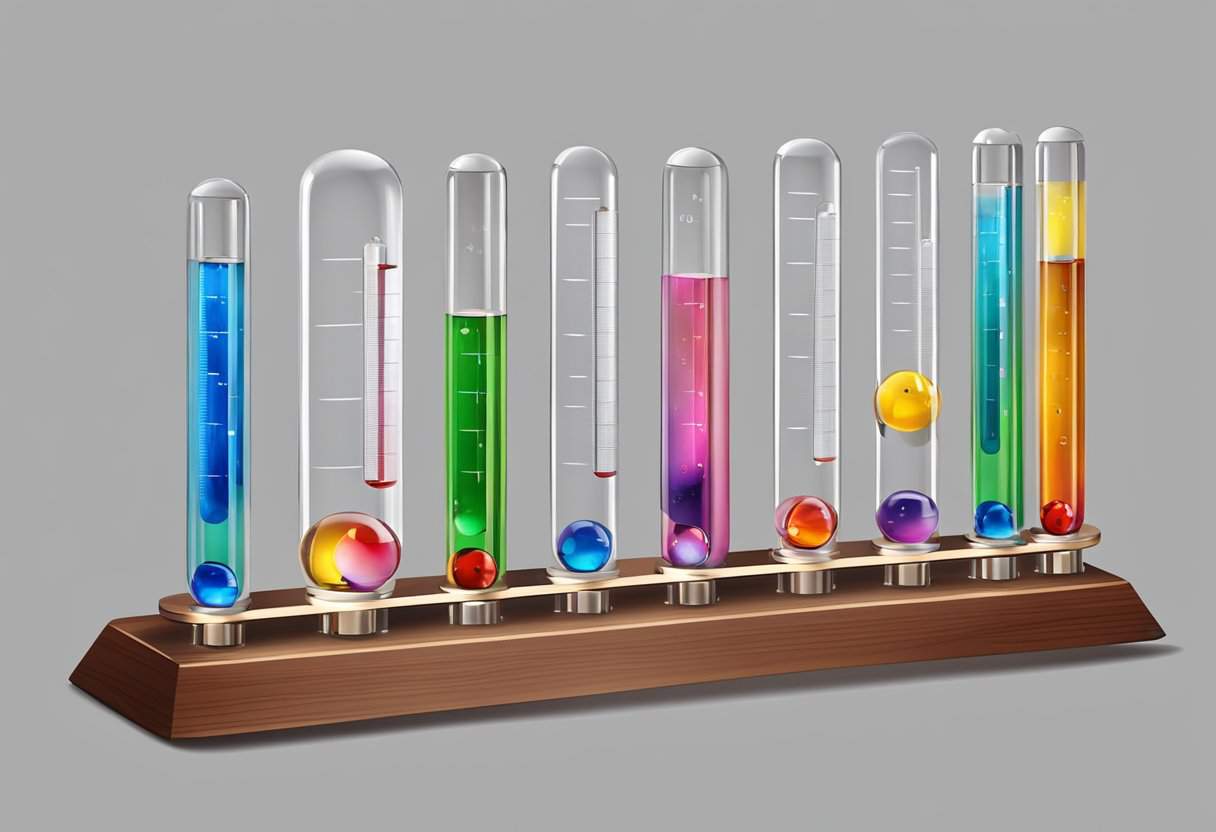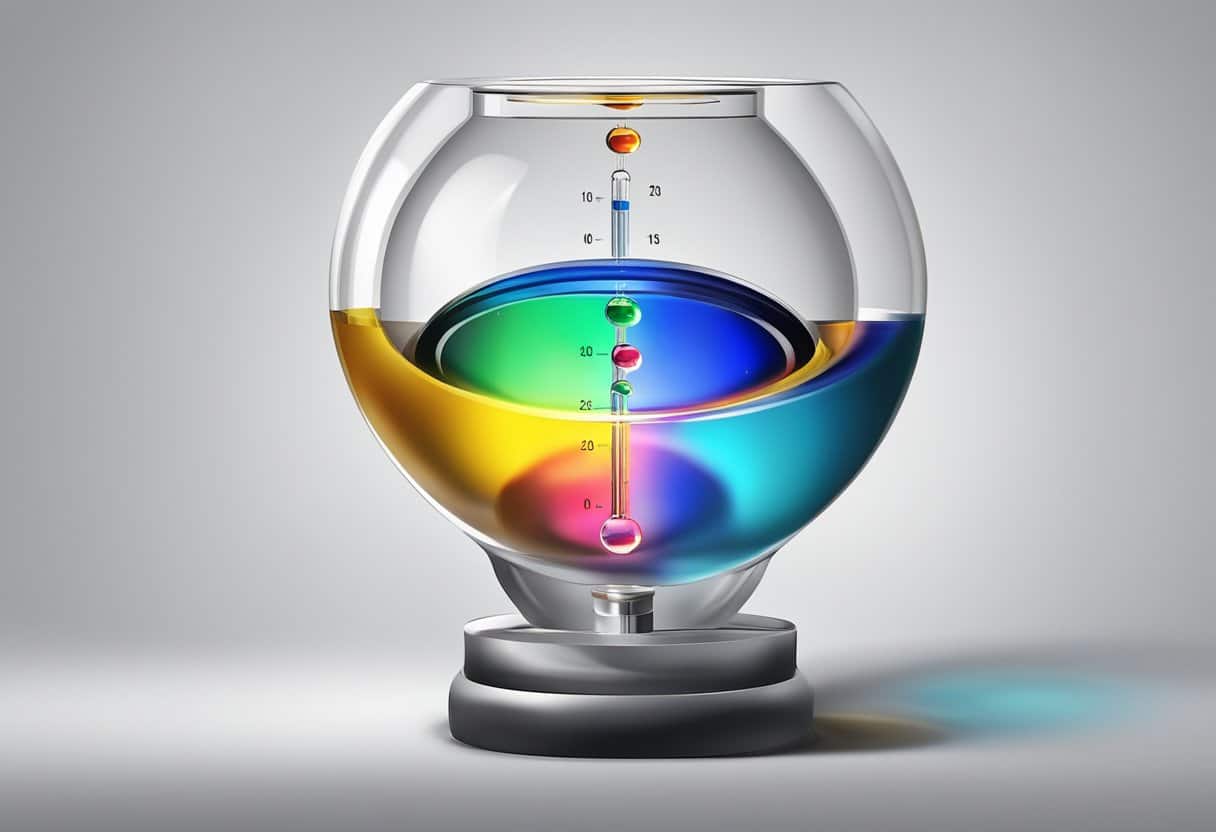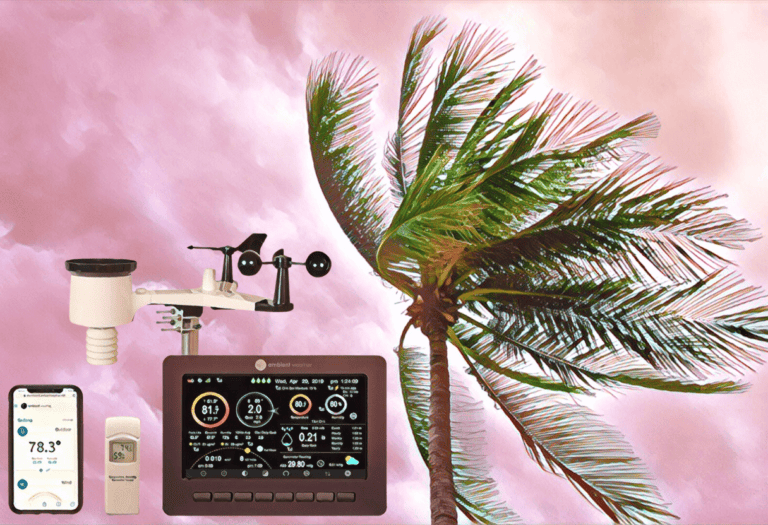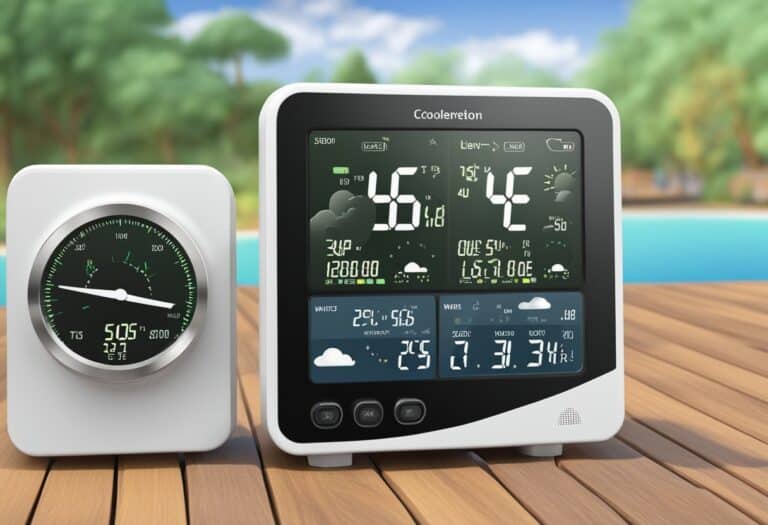A Galileo thermometer is not only a beautiful decorative piece but also a functional instrument that reflects the scientific ingenuity of its namesake, Italian physicist Galileo Galilei.
Having evolved from the early thermoscope to a more refined device, it is a fascinating example of physics applied to meteorology, using density and buoyancy to measure temperature changes. Reading a Galileo thermometer is straightforward once you understand its components: the sealed glass tube contains colored glass spheres, each with a metal tag indicating a temperature.
To determine the current temperature with your Galileo thermometer, observe the group of glass spheres floating in the middle portion of the cylinder. The tagged reading on the lowest of these spheres in the upper cluster provides the ambient temperature. It’s a clever application of the principles of buoyancy and density: as the temperature changes, the fluid in the thermometer changes density, causing the spheres to rise or sink.
Thus, by bearing the legacy of Galileo Galilei, this device continues to couple scientific principles with aesthetic appeal, serving as both an educational tool and an intriguing conversation piece.
To read a Galileo thermometer, look at the floating spheres; the temperature is indicated by the lowest floating sphere in the upper cluster.
Understanding the Galileo Thermometer
The Galileo thermometer, a fusion of art and science, offers a visually engaging way to measure ambient temperature. Comprehending how this device works involves exploring its history, design, and the principles of buoyancy and density.
Historical Background
The Galileo thermometer, as its name suggests, relates to the great scientist Galileo Galilei. Although Galileo is often credited with its invention, the device was refined by his associates at the Accademia del Cimento in Florence. This thermometer builds on the concept that the density of a liquid changes with temperature.
Design and Components
A typical Galileo thermometer consists of a sealed glass cylinder filled with a clear liquid and several glass spheres. Each sphere contains a colored liquid for easy visibility and is attached to a metal tag serving as a calibrated counterweight. These tags often bear a temperature reading and add to the overall functionality and elegance of the thermometer.
Principles of Operation
The operation of Galileo’s thermometer is based on principles of density and buoyancy. As the ambient temperature changes, so does the density of the liquid in the cylinder. This change in density either causes the spheres to float or sink. The spheres themselves have varying densities due to the different amounts of liquid they contain.
How to Read the Temperature
To read the temperature, look for the group of spheres at the bottom of the cylinder. Generally, the temperature is determined by the lowest floating sphere or the highest sphere at the bottom. The attached tags will show you the current temperature based on the density and buoyancy relationship within the thermometer.
Factors Affecting Accuracy
Several factors can affect the accuracy of your Galileo thermometer. Direct sunlight or the air temperature around the thermometer can lead to false readings. The accuracy can also be influenced by the water density within the cylinder and must be calibrated properly during manufacturing. To ensure precise readings, place your thermometer away from windows and other heat sources.
Practical Tips for Using and Maintaining a Galileo Thermometer

A Galileo thermometer provides an elegant and functional decoration, merging scientific principles with visual appeal. Proper placement, regular troubleshooting, and a clear understanding of how to read the temperature tags are essential for accurate readings and long-term enjoyment of your product.
Placement and Care
Choose a location for your Galileo thermometer away from direct sunlight and any sources of artificial heat or coolness to ensure an accurate representation of ambient temperature. Place the thermometer on a steady surface to prevent it from tipping. The glass tube should be free of odors and vapor that could affect the buoyancy of the floating bulbs. Clean the exterior of the thermometer with a soft cloth, avoiding chemicals that might damage the glass or distort the colored liquid mixture inside.
Troubleshooting Common Issues
If you notice the bulbs clustering at the top or bottom of the tube or a significant gap between them, it could indicate an issue with the temperature range of the room or the thermometer itself. Ensure the room’s temperature falls within the thermometer’s design range, typically between approximately 60°F and 80°F (around 15°C and 26°C). If the floating bulbs are stuck, gently tap the side of the thermometer to dislodge them. Never shake the thermometer, as this may damage the delicate glass or affect the calibrated counterweights inside the bulbs.
Understanding Temperature Ranges and Tags
Each bulb within the Galileo thermometer is filled with a certain amount of alcohol or ethanol and a calibrated counterweight, bearing a temperature tag. The tag will often have a temperature range listed in both Celsius and Fahrenheit. Bulbs sink or float based on the density of the surrounding fluid, which changes with temperature. The lowest floating bulb in the upper part of the glass tube, or the highest sinking bulb in the lower part, will give you the current air temperature. The tags are color-coded—green, yellow, purple—for visual beauty and quick reference. Ensure you read the tag at eye level for the most accurate readings and appreciate the mixture of colors as much as the data they provide.
Scientific Concepts Behind the Galileo Thermometer
Understanding the Galileo thermometer requires an appreciation of its basic scientific principles, particularly how density and temperature interact, the role buoyancy plays, and how thermometry has advanced over time.
The Relationship Between Density and Temperature
When you observe a Galileo thermometer, you’re seeing density in action. The sealed glass tube contains a clear liquid and several floating balls, each with attached metal tags indicating a specific temperature. The density of the liquid changes with temperature variations; as the temperature of the liquid increases, its density decreases, and vice versa. This physical principle is central to how the thermometer functions.
Buoyancy and Its Role in the Thermometer
Buoyancy is the force that allows the floating balls in a Galileo thermometer to rise or sink. This force acts against gravity and is determined by the overall density of the balls in comparison to the surrounding liquid. Each ball is precisely weighted, and as the liquid density changes, so does the buoyant force on each ball. The one that hovers in the middle of the tube corresponds to the current ambient temperature.
Advancements in Thermometry
The Galileo thermometer is an example of how thermometry— the science of temperature measurement— has developed since its invention. Named after the famous physicist Galileo Galilei, who developed the precursor to the thermometer known as a thermoscope, this device combines the concept of floating clusters with precise temperature measurement. Its modern elegance is a testament to past innovations in the field of thermometry, yet the principles it uses are timeless.
Additional Information
When using a Galileo thermometer, it is important to understand how temperature differences are read and the educational value it provides, as well as its decorative appeal.
Interpreting Temperature Differences
To accurately read a Galileo thermometer, note that each glass bubble is weighted and contains a temperature tag. As ambient temperature changes, the density of the liquid within the thermometer changes, causing the bubbles to either rise or fall. The bubble floating in the middle of the column gives the current temperature reading. If all bubbles are at the top or bottom, consider the outside temperature tags on the nearest bubbles to estimate the air temperature.
Galileo Thermometer as an Educational Tool
The Galileo thermometer is not just a tool for measuring air temperature; it’s also an excellent educational tool. It teaches principles of physics, specifically, the concept of buoyancy and density. Originating from work by Galileo Galilei, the famous Italian physicist, it can visually demonstrate how changes in density can act as a reading for temperature.
Decoration and Aesthetic Value
Apart from its functional use, a Galileo thermometer is often valued for its appearance. These thermometers are typically made from hand-blown glass and contain liquid of various colors. The combination of functionality, history, and the vibrant color display can make it a charming decoration piece, enhancing the aesthetic appeal of any room it’s placed in.
Frequently Asked Questions
The Galileo thermometer, a device for measuring temperature, operates on the principle of buoyancy and density. This section answers common inquiries about how to read and understand your Galileo thermometer correctly.
How does one interpret the floating balls within a Galileo thermometer?
To read the temperature, observe the floating balls in the thermometer. Each ball is weighted differently and tagged with a temperature reading. The temperature is determined by the ball that hovers in the gap between the top group of balls and the bottom group. If all balls are at the bottom, the temperature is higher than the highest tag; if all are at the top, it’s lower than the lowest tag.
What steps are involved in calibrating a Galileo thermometer for accurate readings?
Calibration involves ensuring the positions of the floating balls represent the correct temperature. Place the thermometer in a controlled environment where you know the actual temperature for reference, then adjust the weights attached to the balls as needed so they correlate to the reference temperature.
Why might a Galileo thermometer cease to function properly, and what can be done to fix it?
A Galileo thermometer may cease to function if the liquid inside is no longer at the correct density, or if the balls become damaged. Adjusting the liquid’s density or replacing damaged balls are potential fixes. Consult the manufacturer for repair options for more complex issues.
What is the level of accuracy of a Galileo thermometer compared to modern thermometers?
Galileo thermometers are generally less accurate than modern digital or mercury thermometers. They are best suited for ambient temperature readings with a typical accuracy range within 2-3 degrees Fahrenheit.
Can you explain the purpose of the colored liquid in a Galileo thermometer?
The colored liquid in a Galileo thermometer isn’t just for aesthetic appeal. It contrasts with the clear glass to provide easier visibility of the floating balls and their corresponding temperature readings.
How do Galileo thermometers integrate with barometric readings for weather prediction?
Galileo thermometers do not measure atmospheric pressure and therefore don’t directly integrate with barometric readings. They are purely temperature measuring devices but can complement a barometer when used together to help predict weather changes.







